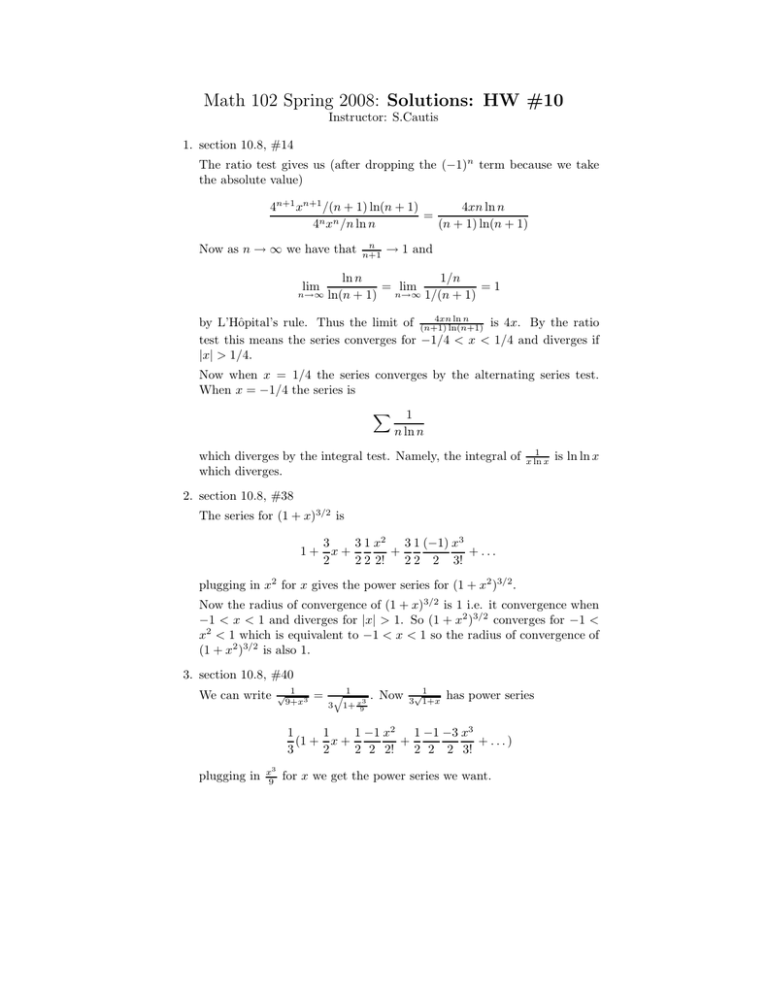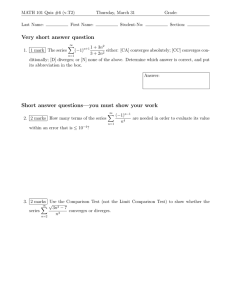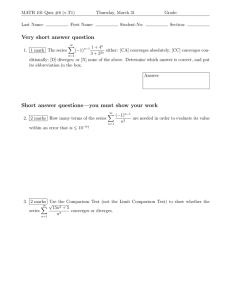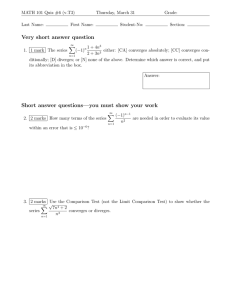Math 102 Spring 2008: Solutions: HW #10
advertisement

Math 102 Spring 2008: Solutions: HW #10 Instructor: S.Cautis 1. section 10.8, #14 The ratio test gives us (after dropping the (−1)n term because we take the absolute value) 4xn ln n 4n+1 xn+1 /(n + 1) ln(n + 1) = 4n xn /n ln n (n + 1) ln(n + 1) Now as n → ∞ we have that lim n→∞ n n+1 → 1 and 1/n ln n = lim =1 ln(n + 1) n→∞ 1/(n + 1) 4xn ln n by L’Hôpital’s rule. Thus the limit of (n+1) ln(n+1) is 4x. By the ratio test this means the series converges for −1/4 < x < 1/4 and diverges if |x| > 1/4. Now when x = 1/4 the series converges by the alternating series test. When x = −1/4 the series is X 1 n ln n which diverges by the integral test. Namely, the integral of which diverges. 1 x ln x is ln ln x 2. section 10.8, #38 The series for (1 + x)3/2 is 3 3 1 x2 3 1 (−1) x3 1+ x+ + + ... 2 2 2 2! 2 2 2 3! plugging in x2 for x gives the power series for (1 + x2 )3/2 . Now the radius of convergence of (1 + x)3/2 is 1 i.e. it convergence when −1 < x < 1 and diverges for |x| > 1. So (1 + x2 )3/2 converges for −1 < x2 < 1 which is equivalent to −1 < x < 1 so the radius of convergence of (1 + x2 )3/2 is also 1. 3. section 10.8, #40 We can write √ 1 9+x3 = q1 3 3 1+ x9 . Now √1 3 1+x has power series 1 1 −1 x2 1 −1 −3 x3 1 (1 + x + + + ...) 3 2 2 2 2! 2 2 2 3! plugging in x3 9 for x we get the power series we want. Now the power series √1 3 1+x converges for −1 < x < 1 so has radius 3 of convergence 1. Thus our power series converges for −1 < x9 < 1 or equivalently −9 < x3 < 9 or equivalently −91/3 < x < 91/3 so the radius of convergence is 91/3 . 4. section 10.8, #42 We know from earlier computations in the chapter that 1 1 tan−1 (x) = x − x3 + x5 − . . . 3 5 so that x − tan−1 (x) = 1 3 1 5 x − x + ... 3 5 and dividing by x3 we get 1 1 2 1 4 − x + x − ... 3 5 7 Now the original power series for tan−1 (x) converges for −1 < x < 1 and subtracting x or dividing by x3 does not change this fact. So the radius of convergence is 1. 5. section 10.8, #44 We know that sin t has power series t− so that sin t t t3 t5 + − ... 3! 5! has power series 1− t4 t2 + − ... 3! 5! and integrating term by term we get t− t3 t5 + − ... 3 · 3! 5 · 5! 6. section 10.8, #48 The power series for 1 1−t2 is 1 + t2 + t4 + t6 + . . . so integrating term by term we get t+ t3 t5 t7 + + + ... 3 5 7 7. section 10.8, #50 P n We know that x = P n−1 nx sums up to 1 1−x . Differentiating term by term we get that d 1 1 = dx 1 − x (1 − x)2 P Now differentiating again we get n(n − 1)xn−2 sums up to 1 2 d = dx (1 − x)2 (1 − x)3 P Multiplying by x2 we get that n(n − 1)xn sums up to 2x2 . (1 − x)3 8. section 10.8, #52 P n We know that nx = x (1−x)2 so plugging in x = 1/2 we get X n 1/2 = =2 2n (1 − 1/2)2 Similarly, we know that X n2 xn = x(1 + x) (1 − x)3 so plugging in x = 1/3 we get X n2 3n = 1/3(1 + 1/3) 4/9 = = 3/2 3 (1 − 1/3) 8/27 9. page 814 #38 Using the ratio test we get x ln n xn+1 / ln(n + 1) = xn / ln n ln(n + 1) which converges to x as n → ∞. Thus the series converges for −1 < x < 1 and diverges for |x| > 1. P (−1)n Now when x = −1 the series P 1 ln n converges by the alternating series test. P When x = 1 we get ln n which diverges by the comparison test 1 (which in turn diverges by the integral test). with n 10. page 814 #40 Again we use the ratio test to get 1 n+1 (x − 1)n+1 n+1 ) (1 + n1 )n (x − 1)n (1 + Now we know that (1 + n1 )n tends to the constant e as n → ∞. So the limit above as n → ∞ is equal to ee (x − 1) = x − 1. So the series converges if −1 < x − 1 < 1 or equivalently if 0 < x < 2. It diverges if x − 1 > 1 or x − 1 < −1 or equivalently if x > 2 or x < 0. Finally, if x = 0 or x = 2 the series diverges since the individual terms in the series do not tend to zero (their absolute value tends to e).




